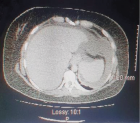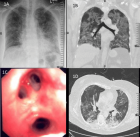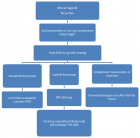Abstract
Research Article
Atypical manifestations of pulmonary embolism
Oscar MP Jolobe*
Published: 16 April, 2020 | Volume 4 - Issue 1 | Pages: 008-018
Pulmonary embolism (PE) is an age-related disorder which is potentially fatal, but frequently misdiagnosed. However, the true prevalence of pulmonary embolism is unknown. Inaccurate estimates of PE prevalence might, in part, be attributable to underrecognition of atypical presentations of this disorder. If true prevalence is unknown, the positive predictive values of both typical and atypical symptoms and signs of PE will be unreliable. The negative predictive value of those parameters will, likewise, be unreliable. The aim of this review is to make clinicians more aware of atypical manifestations of PE, thereby increasing the likelihood of correct diagnosis and, hence, ascertainment of the true prevalence of PE. The range of atypical manifestations was explored by a literature search, using MEDLINE from 1946 to February 2019, and EMBASE, from 1947 to February 2019, and Pubmed, from February 2014 to February 2019, using the search terms atypical, uncommon, unusual, pulmonary embolism, lung embolism, pulmonary thromboembolism.
This search revealed atypical presenting features such as non pleuritic retrosternal pain, abdominal pain, atypical breathing patterns, pulmonary oedema, Dressler’s syndrome, atypical radiographic manifestations, atypical electrocardiographic features, manifestations associated with oxygen saturation of 95% or more, coexistence of acute myocardial infarction and pulmonary embolism, coexistence of thoracic aortic dissection and pulmonary embolism, neurological manifestations other than stroke, paradoxical embolism, acute venous thrombosis of atypical location, and pulmonary embolism with normal D-dimer levels.
Read Full Article HTML DOI: 10.29328/journal.avm.1001012 Cite this Article Read Full Article PDF
Keywords:
Pulmonary; Embolism; Atypical; Manifestations
References
- Wells PS, Ginsberg JS, Anderson DR, Kearon C, Gent M, et al. Use of a clinical model for safe management of patients with suspected pulmonary embolism. Ann Intern Med. 1998; 129: 997-1005. PubMed: https://www.ncbi.nlm.nih.gov/pubmed/9867786
- Wells PS, Anderson DR, Rodger M, Ginsberg JS, Kearon C, et al. Derivation of a simple clinical model to categorize patients probability of pulmonary embolism: Increasing the model’s utility with the simpliRED D-dimer. Thromb Haemost. 2000; 83: 416-420. PubMed: https://www.ncbi.nlm.nih.gov/pubmed/10744147
- Kline JA, Mitchell AM, Kabrhel C, Richman PB, Courtney DM, Clinical criteria to prevent unnecessary diagnostic testing in emergency department patients with suspected pulmonary embolism. J Thromb Haemost 2004; 2: 1247-1255. PubMed: https://www.ncbi.nlm.nih.gov/pubmed/15304025
- Kline JA, Courtney DM, Kabrhel C, Moore CL, Smithline HA, et al. Prospective multicentre evaluation of the pulmonary embolism rule-out criteria. J Thromb Haemost. 2008; 6: 772-780. PubMed: https://www.ncbi.nlm.nih.gov/pubmed/18318689
- Pauker S, Kassirer JP. The threshold approach to clinical decision making. N Engl J Med. 1980; 302: 1109-1117. PubMed: https://www.ncbi.nlm.nih.gov/pubmed/7366635
- Turedi S, Erdem E, Karaca Y, Tatli O, Sahin A, et al. The high risk of contrast-induced nephropathy in patients with suspected pulmonary embolism despite three different prophylaxis: A randomized controlled trial. Acad Emerg Med. 2016; 23: 1136-1145. PubMed: https://www.ncbi.nlm.nih.gov/pubmed/27411777
- Kabrhel C, Camargo CA, Goldhaber SZ. Clinical gestalt and the diagnosis of pulmonary embolism: does experience matter? CHEST 2005; 127: 1627-1630. PubMed: https://www.ncbi.nlm.nih.gov/pubmed/15888838
- Egermayer P, Town GI, Turner JG, Heaton DC, Mee A, et al. Usefulness of D-dimer, blood gas, and respiratory rate measurements for excluding pulmonary embolism. Thorax. 1998; 53: 830-834. PubMed: https://www.ncbi.nlm.nih.gov/pmc/articles/PMC1745091/
- Garcia-Fuster MJ, Fabia MJ, Furio E, Pichler G, Redon MJ, et al. Should we look for silent pulmonary embolism in patients with deep venous thrombosis? BMC Cardiovascular Disorders. 2014; 14: 178. PubMed: https://www.ncbi.nlm.nih.gov/pubmed/25487168
- Cha SI, Shin KM, Lee JW, Lee J, Lee SY, et al. Clinical characteristics of patients with peripheral pulmonary embolism. Respiration. 2010; 80: 500-508. PubMed: https://www.ncbi.nlm.nih.gov/pubmed/20110642
- Riedel M. Acute pulmonary embolism. 1: pathophysiology, clinical presentation, and diagnosis. Heart. 2001; 85: 229-240. PubMed: https://www.ncbi.nlm.nih.gov/pmc/articles/PMC1729607/
- Kukla P, Diugopolski R, Krupa E, Furtak R, Mirek-Bryniarska E, et al. How often pulmonary embolism mimics acute coronary syndrome? Kardiologia Polska. 2011; 69: 235-240. PubMed: https://www.ncbi.nlm.nih.gov/pubmed/21432791
- Villablanca PA, Vlismas PP, Aleksandrovich T, Omondi A, Gupta T, et al. Case report and systematic review of pulmonary embolism mimicking ST-elevation myocardial infarction. Vascular. 2019; 27: 90-97. PubMed: https://www.ncbi.nlm.nih.gov/pubmed/30056785
- Boukantar M, Lim P, Mitchell-Heggs L. Right ventricular thrombus and pulmonary embolism in a patient with anterior myocardial infarction. Eur Heart J. 2010; 31: 2870. PubMed: https://www.ncbi.nlm.nih.gov/pubmed/20693171
- Alkhalil M, Cahill TJ, Boardaman H, Choudhury RP. Concomitant pulmonary embolism and myocardial infarction due to paradoxical embolism across a patent foramen ovale. Eur Heart J Case Reports. 2017; 1: 1-4. PubMed: https://www.ncbi.nlm.nih.gov/pubmed/31020069
- Al-Mane N, Al-Mane F, Abdalla Z, McDonnell J. Acute surgical abdomen: An unusual presentation of pulmonary embolus. J Investig Med High Impact Case Rep. 2014; 2: 2324709614542339. PubMed: https://www.ncbi.nlm.nih.gov/pubmed/26425615
- Pilipp J, Norbert W, Thomas G. Young woman with dyspnoea and upper abdominal pain. Eur J Intern Med. 2019; 59: e1-e2. PubMed: https://www.ncbi.nlm.nih.gov/pubmed/29754937
- Gantner J, Keffeler J, Derr C. Pulmonary embolism: An abdominal pain masquerader. J Emerg Trauma Shock. 2013; 6: 280-282. PubMed: https://www.ncbi.nlm.nih.gov/pubmed/24339662
- Fallahi MJ, Masoompour S, Mirzaee M. Pulmonary embolism with abdominal pain and ST elevation: A case report. Iran J Med Sci. 2014; 39: 395-398. PubMed: https://www.ncbi.nlm.nih.gov/pmc/articles/PMC4100053/
- Hodkinson EC, Noad RL, menown IBA. Massive pulmonary embolus presenting with abdominal pain. Ulster Med J. 2012; 81: 98. PubMed: https://www.ncbi.nlm.nih.gov/pmc/articles/PMC3605544/
- Lusiani L, Perrone A, Pesavento R, Conte G. Prevalence, clinical features, and acute course of atypical myocardial infarction. Angiology. 1994; 45: 49-55. PubMed: https://www.ncbi.nlm.nih.gov/pubmed/8285384
- Israel HL, Goldstein F. The varied clinical manifestations of pulmonary embolism. Ann Intern Med. 1957; 47: 202-226. PubMed: https://www.ncbi.nlm.nih.gov/pubmed/13459102
- Heavrin BS, Wrenn K. Ovarian vein thrombosis: a rare cause of abdominal pain outside the peripartum period. J Emerg Med. 2008; 34: 67-69. PubMed: https://www.ncbi.nlm.nih.gov/pubmed/18194726
- Vavuranakis M, Lazaros G, Patialiakas A, maragiannis D, Papaioannou, et al. A young woman with syncope, dyspnoea and abdominal pain. Hellenic J Cardiol. 2009; 50: 218-220. PubMed: https://www.ncbi.nlm.nih.gov/pubmed/19465364
- Turedi S, Gunduz A, Eroglu O. Paradoxical embolism involving 4 organ systems(pulmonary, renal, splenic, and hepatic artery). Am J Emerg Med. 2007; 25: 737.e1-737.e3. PubMed: https://www.ncbi.nlm.nih.gov/pubmed/17606114
- Hosein AS, Mahabir V, Konduru SKP, Giddings SL. Pulmonary embolism: An often forgotten differential diagnosis for abdominal pain. QJ Med. 2019; 112: 689-690. PubMed: https://www.ncbi.nlm.nih.gov/pubmed/31173142
- Rehman H, John E, Parikh P. Pulmonary embolism presenting as abdominal pain: An atypical presentation of a common diagnosis. Case Reports in Emergency Medicine. 2016; 2016: 7832895. PubMed: https://www.ncbi.nlm.nih.gov/pmc/articles/PMC5013217/
- Cohen D, Lyon M, Johnson RP. Frequency of abdominal pain as the presenting complaint in pulmonary embolism. Ann Emergency Med. 2008; 52: S 137; Poster 315.
- Stein PD, Beemath A, Matta F, Weg JG, Yusen RO, et al. Clinical characteristics of patients with acute pulmonary embolism: Data from PIOPED II. Am J Med. 2007; 120: 871-879. PubMed: https://www.ncbi.nlm.nih.gov/pubmed/17904458
- Miniati M, Monti S, Bottai M. A structured clinical model for predicting the probability of pulmonary embolism. Am J Med. 2003; 114: 173-179. PubMed: https://www.ncbi.nlm.nih.gov/pubmed/12637130
- Alonso-Martinez JL, Sanchez FJA, Echezarreta U. Delay and misdiagnosis in sub-massive and non-massive acute pulmonary embolism. Eur J Intern Med. 2010; 21: 278-282. PubMed: https://www.ncbi.nlm.nih.gov/pubmed/20603035
- Salvetti M, Bazza A, Paini A, Bertacchini F. Platypnoea orthodeoxia with pulmonary embolism. American J Emerg Med. 2013; 31: 760e1-760e2. PubMed: https://www.ncbi.nlm.nih.gov/pubmed/23380102
- Windebank WJ, Boyd G, Moran F. Pulmonary thromboembolism presenting as asthma. Br Med J. 1973; 1: 90-94. PubMed: https://www.ncbi.nlm.nih.gov/pmc/articles/PMC1588813/
- Calvo-Romero JM, Perez-Miranda M, Bureo-Dacal P. Wheezing in patients with acute pulmonary embolism with and without previous cardiopulmonary disease. Eur J Emerg Med. 2003; 10: 288-289. PubMed: https://www.ncbi.nlm.nih.gov/pubmed/14676506
- Zoller B, Pirouzifard M, Memon AA, Sundquist J, Sundquist K, Risk of pulmonary embolism and deep vein thrombosis in patients with asthma: a nationwide case-control study from Sweden. Eur J Respir J 2017; 49: 1601-1614 PubMed: https://www.ncbi.nlm.nih.gov/pubmed/28202551
- Aleva FE, Voets LWM, Simons SO, de Mast Q, van der Ven AJAM, et al. Prevalence and localization of pulmonary embolism in unexplained acute exacerbations of COPD. CHEST 2017; 151: 544-554. PubMed: https://www.ncbi.nlm.nih.gov/pubmed/27522956
- Polverino F, Ricciardi M. Voice box symptoms: A hitherto unknown presentation of pulmonary embolism. Am J Respir Crit Care Med. 2013; 187: 108-110. PubMed: https://www.ncbi.nlm.nih.gov/pubmed/23281354
- Webster JR, Saadeh GB, Eggum PR, Suker JR. Wheezing due to pulmonary embolism-Treatment with heparin. N Engl J Med 1966; 274: 931-933. PubMed: https://www.ncbi.nlm.nih.gov/pubmed/5908886
- Hassen G, Singh MM, Yemane-Merriwether S, Ferrante A, Shaw R. Persistent hiccups as a rare presenting symptom of pulmonary embolism. Western J Emerg Med. 2012; 13: 479-484. PubMed: https://www.ncbi.nlm.nih.gov/pubmed/23359617
- Williams AJ, Yauch DC, Finberg SN, Santiago SM, Fisher HK. Pulmonary embolism presenting as adult respiratory distress syndrome-support for a hypothesis. Postgrad Med J. 1982; 58: 290-292. PubMed: https://www.ncbi.nlm.nih.gov/pmc/articles/PMC2426424/
- Famularo G, Minisola G, Nicotra GC, De Simone C. Massive pulmonary embolism masquerading as pulmonary edema. Amer J Emerg Med. 2007; 25: 1086.eq-1086.e2. PubMed: https://www.ncbi.nlm.nih.gov/pubmed/18022516
- Kazza F, Demla V, Cherian S. Unilateral pulmonary edema, Westermark’s sign and Palla’s sign in pulmonary embolism. Q J Med 2017; 110: 459-460. PubMed: https://www.ncbi.nlm.nih.gov/pubmed/28339667
- Elliott CG, Goldhaber SZ, Visani L, De Rosa M. Chest radiographs in acute pulmonary embolism. Results from the International Cooperative Pulmonary Embolism registry. CHEST 2000; 118: 33-38. PubMed: https://www.ncbi.nlm.nih.gov/pubmed/10893356
- Sisk PB. Pulmonary thromboembolism: Atypical clinical and roentgen manifestations. CHEST. 1965; 47; 539-548. PubMed: https://www.ncbi.nlm.nih.gov/pubmed/14285343
- Mathieson P, Reckless I, Ferrett C. Secondary spontaneous pneumothorax: a rare complication of pulmonary embolism. BMJ Case Rep . 2012; PubMed: https://www.ncbi.nlm.nih.gov/pubmed/23109413
- Kadam S, Joshi JM. Pulmonary cavitation and hydropneumothorax associated with pulmonary embolism. Indian J Chest Dis Allied Sci 2012; 54: 119-121. PubMed: https://www.ncbi.nlm.nih.gov/pubmed/22973782
- Vidal E, LeVeen HH, Yarnoz M, Piccone VA. Lung abscess secondary to pulmonary infarction. Ann Thorac Surg. 1971; 11: 557-564. PubMed: https://www.ncbi.nlm.nih.gov/pubmed/5579103
- Maldjian PD, Petscavage JM. Intracardiac thrombus and pulmonary embolism with cavitation and pneumomediastinum in a patient with protein S deficiency. J Thorac Imaging 2006; 21: 222-224. PubMed: https://www.ncbi.nlm.nih.gov/pubmed/16915068
- Jerjez-Sanchez C, Ibarra-Perez C, Ramirez-Rivera A, Padua-Gabriel A, Gonzalez-Carmora VM. Dressler-like syndrome after pulmonary embolism and infarction. CHEST. 1987; 92: 115-117. PubMed: https://www.ncbi.nlm.nih.gov/pubmed/3595222
- Agarwal R, Singh N, Gupta D. Pleural effusion associated with pulmonary thromboembolism: A systematic review. Indian J Chest Dis Allied Sci. 2009; 51: 159-164.
- Larsen TR, Ball TC. Chronic pulmonary embolism in a young athletic woman. Proc Baylor Univ Med Cent. 2015; 28: 371-374. PubMed: https://www.ncbi.nlm.nih.gov/pmc/articles/PMC4462227/
- Kahanov L, Daly T. Bilateral pulmonary emboli in a collegiate gymnast. J Athl Train. 2009; 44: 666-671. PubMed: https://www.ncbi.nlm.nih.gov/pmc/articles/PMC2775370/
- Durning SJ, Shaw DJ, Oliva AJ, Morris MJ. Persistent hiccups as the presenting symptom of a pulmonary embolism. Chest Disease Reports 2012; 2 e2.
- Mansmann EH, Singh A. Pulmonary thromboembolism presenting with abdominal symptoms. Am J Case Rep 2012; 13: 137-139. PubMed: https://www.ncbi.nlm.nih.gov/pmc/articles/PMC3616185/
- Amesquita M, Cocchi MN, Donnino MW. Pulmonary embolism presenting as flank pain: A case series. J Emerg Med 2012; 42: e97-e100. PubMed: https://www.ncbi.nlm.nih.gov/pubmed/19327937
- Boari B, Bergami E, Manfredini R. Abdominal and flank pain as an unusual presentation of pulmonary embolism: A case report. J Am Geriatr Soc. 2005; 53: 1259-1260. PubMed: https://www.ncbi.nlm.nih.gov/pubmed/16108951
- Migneault D, Levine Z, de Champlain F. An unusual presentation of a massive pulmonary embolism with misleading investigation results treated with tenecteplase. Case Rep Emerg Med. 2015; 2015: 868519. PubMed: https://www.ncbi.nlm.nih.gov/pmc/articles/PMC4350959/
- Sethuraman U, Siadat M, Lepak-Hitch CA, Haritos D. Pulmonary embolism presenting as acute abdomen in a child and adult. Am J Emerg Med. 2009; 27: 514.e1-514.e5. PubMed: https://www.ncbi.nlm.nih.gov/pubmed/19555633
- Noble J, Singh A. Asymptomatic pulmonary embolus masquerading as anteroseptal myocardial infarction. CJEM. 2011; 13: 62-65. PubMed: https://www.ncbi.nlm.nih.gov/pubmed/21324301
- Falterman TJ, Martinez JA, Daberkow D, Weiss LD. Pulmonary embolism with ST segment elevation in leads V1 to V4: Case report and review of the literature regarding electrocardiographic changes in acute pulmonary embolism. J Emerg Med. 2001; 21: 255-262. PubMed: https://www.ncbi.nlm.nih.gov/pubmed/11604280
- Lee DZ, Whittaker M, Al-Mohammad A. An unusual presentation of pulmonary embolism. BMJ Case Reports 2012; 2012: bcr2012006210.. PubMed: https://www.ncbi.nlm.nih.gov/pmc/articles/PMC4542928/
- Pillarisetti J, Gupta K. Giant inverted T waves in the emergency department: case report and review of differential diagnoses. J Electrocardiol. 2010; 43: 40-42. PubMed: https://www.ncbi.nlm.nih.gov/pubmed/19781716
- Alreshq R, Hsu G, Torosoff M. Acute pulmonary embolism presenting with symptomatic bradycardia: a case report and review of the literature. Am J case Rep. 2019; 20: 748-752. PubMed: https://www.ncbi.nlm.nih.gov/pubmed/31130721
- Lu SH, Wu YS, Huang SC, Lin CS. A rare case of pulmonary embolism and seizure in a young man: Antiphospholipid syndrome. Acta Cardiol Sin. 2016; 32: 247-249. PubMed: https://www.ncbi.nlm.nih.gov/pmc/articles/PMC4816925/
- Meyer MA. Seizure as the presenting sign for massive pulmonary embolism: Case report and review of literature. Seizure. 2009; 18; 76-78. PubMed: https://www.ncbi.nlm.nih.gov/pubmed/18656385
- Bhatty O, Jhand AS, Alkhafaji N, Mooss A. Challenge in clinical decision making: A patient with type B aortic dissection presenting with pulmonary embolism. Am J Resp Crit Care Med. 2017; 195: A4179.
- Al-Zuabi S, Varkey AP, Abdalmaksoud SF, Alothman HS, Alrashdan I. A rare case of leaking thoracic aortic aneurysm in a patient with massive pulmonary embolism. Egy J Int Med. 2013; 25: 47-50.
- Tomaszuk-Kazberuk A, Sobkowicz B, Lewczuk A, Prokop JB, Sawicki R, et al. Silent pulmonary embolism in a patient with acute myocardial infarction and type B acute aortic dissection-a case report. Adv Med Sci. 2010; 55: 99-102. PubMed: https://www.ncbi.nlm.nih.gov/pubmed/20371437
- Raghav KPS, Makkuni P, Figueredo VM. A review of electrocardiography in pulmonary embolism: recognizing pulmonary embolus masquerading as ST-segment elevation myocardial infarction. Rev Cardiovasc Med 2011; 12: 157-163. PubMed: https://www.ncbi.nlm.nih.gov/pubmed/22145193
- Casazza F, Pacchetti I, Rulli E, Roncon L, Zonzin P, et al. Prognostic significance of electrocardiogram at presentation in patients with pulmonary embolism of different severity. Thromb Res. 2018; 163: 123-127. PubMed: https://www.ncbi.nlm.nih.gov/pubmed/29407623
- Kasmani R, Okoli K, Mohan G, Casey K, Ledrick D. Transient left bundle branch block ; An Unusual electrocardiogram in acute pulmonary embolism. Am J Med Sci. 2009; 337: 381-382. PubMed: https://www.ncbi.nlm.nih.gov/pubmed/19322065
- Wynne J, Littmann L. Brugada electrocardiogram associated with pulmonary embolism. Int J Cardiol. 2013; 162: e32-e33. PubMed: https://www.ncbi.nlm.nih.gov/pubmed/22664370
- Lippolis A, Buzzi MP, Romano IJ, Facchini C, gentile F. Syncope in a patient with acute pulmonary embolism and Brugada Type-2 ECG pattern: Brugada phenocopy or Brugada syndrome? J Eelectrocardiol. 2019; 54: 90-92. PubMed: https://www.ncbi.nlm.nih.gov/pubmed/30965210
- Zuin M, Rigatelli G. Complete heart block as presenting symptom of massive pulmonary embolism in an elderly patient. J Geriatric Cardiol. 2017; 14; 593-594.
- Kurkciyan I, Meron G, Sterz F, Janata K, Domanovits H, et al. Pulmonary embolism as a cause of cardiac arrest. Presentation and outcome Arch Intern Med. 2000; 160: 1529-1535. PubMed: https://www.ncbi.nlm.nih.gov/pubmed/10826469
- Sharifi M, Berger J, Beeston P, Bay C, Vajo Z, et al. Pulseless electrical activity in pulmonary embolism treated with thrombolysis(from the “PEAPETTI” study). Amer J Emergency Med. 2010; 34: 1963-1967.
- Bikdeli B, Ziki MDA, Lip GYH. Pulmonary embolism and atrial fibrillation: two sides pf the same coin? A systematic review. Semin Thromb Hemost. 2017; 43; 849-863. PubMed: https://www.ncbi.nlm.nih.gov/pubmed/28196379
- Leitman IM, Suzuki K, Wengrofsky AJ, Mebashe E, Poplawski M, et al. Early recognition of acute thoracic aortic dissection and aneurysm. World J Emer Sur. 2013; 8: 47. PubMed: https://www.ncbi.nlm.nih.gov/pubmed/24499618
- Warburton MS, Jackson MA, Norton R, Bhabra M. Rare causes of haemoptysis in suspected pulmonary embolism. BMJ. 2004; 329; 557-558. PubMed: https://www.ncbi.nlm.nih.gov/pmc/articles/PMC516111/
- Cui JS, Jing ZP, Zhuang SJ, Zhou JW, Zhang W, et al. D-dimer as a biomarker for acute aortic dissection A systematic review and meta-analysis. Medicine. 2015; 94: e471. PubMed: https://www.ncbi.nlm.nih.gov/pubmed/25634194
- Lee FY, Chen WK, Chiu CH, Lin CL, Kao CH, et al. Increased risk of deep vein thrombosis and pulmonary thromboembolism in patients with aortic aneurysms: A nationwide cohort study. PLOS one. 2017; 12: e178587. PubMed: https://www.ncbi.nlm.nih.gov/pubmed/28591152
- Leu HS, Yu WC. Massive pulmonary embolism in a patient with Type A Aortic dissection. Clin Cardiol. 2005; 28: 53. PubMed: https://www.ncbi.nlm.nih.gov/pmc/articles/PMC6654068/
- Akgul E, Erkul SA, Erkul S, Vural AH. Deep vein thrombosis and pulmonary embolism in a patient with acute type B aortic dissection: a case report. Eur Res J. 2019; 5; 202-205.
- M’Iodoran, I’Iodoran C. High risk pulmonary embolism in a patient with acute dissecting aortic aneurysm. Niger J Clin Pract. 2016; 19: 831-833. PubMed: https://www.ncbi.nlm.nih.gov/pubmed/27811460
- Ramponi F, Papps T, Edwards J. Successful repair of a concomitant acute Type A aortic dissection and saddle pulmonary embolism. Aorta (Stamford). 2018; 6: 34-36. PubMed: https://www.ncbi.nlm.nih.gov/pmc/articles/PMC6136673/
- Chai DZ, Zhang H Y, Zhang F. Pulmonary embolism and Stanford Type B aortic dissection in the same patient. J Vascu Med Sur. 2015; 3; 6.
- Cruz I, Caldera D, Stuart B, Cale R, Joao I, Cotrim C, et al. A case of pulmonary thromboembolism and aortic dissection: The role of echocardiography. Rev Port Cardiol. 2013; 32: 549-550. PubMed: https://www.ncbi.nlm.nih.gov/pubmed/23731736
- Prandoni P, Lensing AWA, Prins MH, Ciammaichella M, Perlati M, et al. Prevalence of pulmonary embolism among patients hospitalized for syncope. N Engl J Med. 2016; 375; 1524-1531. PubMed: https://www.ncbi.nlm.nih.gov/pubmed/27797317
- Carrascosa MF, Batan AM, Novo MF. Delirium and pulmonary embolism in the elderly. Mayo Clin Proc. 2009; 84: 91-92. https://www.ncbi.nlm.nih.gov/pmc/articles/PMC2664576/
- Tanislav C, Piulle M, Pabst W, Reichenberger F, Grebe M, et al. High frequency of silent pulmonary embolism in patients with. cryptogenic stroke and patent foramen ovale. Stroke.. 2011; 42: 822-824. PubMed: https://www.ncbi.nlm.nih.gov/pubmed/21257827
- Sipola P, Hedman M, Jakala P, Karjalainen AM, Peuhkurinen K, et al. Prevalence of pulmonary embolism in patients with suspected cardioembolic ischemic stroke. J Thorac Imaging. 2011; 1: 32-35. PubMed: https://www.ncbi.nlm.nih.gov/pubmed/20489661
- Abusnina W, Megri M, Edris B, El-Hamdani M. Arterial embolism in a patient with pulmonary embolism and patent foramen ovale. Proc Bayl Univ Med. 2019; 32: 256-258. PubMed: https://www.ncbi.nlm.nih.gov/pmc/articles/PMC6541092/
- Belvis R, Masjuan J, Garcia-Barragan N, Cocho D, Marti-Fabregas J, et al. Stroke and pulmonary thromboembolism after a long flight. Eur J Neurol. 2005; 12: 732-734. PubMed: https://www.ncbi.nlm.nih.gov/pubmed/16128878
- Bazan SG, Braga GP, Luvizutto GJ, Trindade AP, Pontes-Neto OM, et al. Bihemispheric paradoxical cerebral embolism in a patient with pulmonary thromboembolism and presumptive fistula right-to-left shunt. J Stroke Cerebrovasc Dis. 2016; 25: e95-e97. PubMed: https://www.ncbi.nlm.nih.gov/pubmed/27105566
- Liu M, Menzoian JO. A patient with multiple paradoxical emboli. J Vasc Surg. 2016; 63: 1085-1087. PubMed: https://www.ncbi.nlm.nih.gov/pubmed/26033010
- Vyas A, Singh A, Vyas P, Kranis M, Pacifico L, et al. A rare case of simultaneous pulmonary and paradoxical emboli with a thrombus straddling a patent foramen ovale. J Cardiol Cases. 2011: 4: e47-e49. PubMed: https://www.ncbi.nlm.nih.gov/pubmed/30532868
- Gansera B, Bauer M, Gansera L, Eichinger W. Acute bilateral pulmonary embolism and complete occlusion of the left internal carotid artery caused by paradoxical embolus through a persistent foramen ovale in a 32 year old woman. J Thorac Cardiovasc Surg. 2013; 145: e67-e69. PubMed: https://www.ncbi.nlm.nih.gov/pubmed/23523034
- Lapoastolle F, Borron SW, Surget V, Lapandry C, Adnet F. Stroke associated with pulmonary embolism after air travel. Neurology. 2003; 60: 1983-1985. PubMed: https://www.ncbi.nlm.nih.gov/pubmed/12821746
- Facciorusso A, Stanisiao M, Pacilli MA, de Luca G, Di Stoifo G, et al. Pulmonary and paradoxical embolism after fracture of the big toe in a patient with patent foramen ovale. J Clin Exper Cardiol. 2012; 3: 12.
- Almaghraby A, Saleh Y, Hammad B, Abdeinaby M, Kandil AE, et al. A rare case of paradoxical embolism. Interventional Cardiol. 2017; 9: 43-44.
- Mirijello A, D’Errico MM, Curci S, Spatuzza P, Graziano D, et al. Paradoxical embolism with thrombus stuck in a patent foramen ovale: a review of treatment strategies. European Review for Medical and Pharmacological Sciences 2018; 22; 8885-8890. PubMed: https://www.ncbi.nlm.nih.gov/pubmed/30575931
- Kumar T, Budnur SC, Mahadevappa NC, Singla V. Paradoxical embolism via a patent foramen ovale. BMJ Case Reports 2013.
- Cameron SJ, Laskurain E, Holcman K, Richeson JF, Mieszczanska H. Treacherous travellers: Emboli. Am J Med. 2015; 128: 695-698. PubMed: https://www.ncbi.nlm.nih.gov/pubmed/25747190
- Dada R, Dada J, Abdelsalam M, Agrawal Y. Thrombus straddling a patent foramen ovale, pulmonary embolism and paradoxical embolism: a rare trifecta. BMJ Case Rep. 2018; pii: bcr-2018-227505 PubMed: https://www.ncbi.nlm.nih.gov/pubmed/30337292
- Miriyala V, Awan MU, Faraj K, Nagra B. Traversing boundaries: thrombus in transit with paradoxical embolism. J Community Hosp Intern Med Perspect. 2016: 6: 31438. PubMed: https://www.ncbi.nlm.nih.gov/pubmed/27609716
- Yeh KH, Chang HC. Massive pulmonary embolism with anterolateral ST-segment elevation: electrocardiocardiogram limitations and the role of echocardiogram. Am J Emerg Med. 2008; 26: 632.e1-632.e3. PubMed: https://www.ncbi.nlm.nih.gov/pubmed/18534307
- ashimoto T, Ando M, Kan T, Fujishima N, Yamasue M, et al. Asthma exacerbation coincident with saddle pulmonary embolism and paradoxical embolism. Tohoku J Ecp Med. 2019; 248: 137-141. PubMed: https://www.ncbi.nlm.nih.gov/pubmed/31243182
- Morpurgo M, Schmid C, Mandelli V. Factors influencing the clinical diagnosis of pulmonary embolism: Analysis of 229 post mortem cases. Int J Cardiol. 1998; 65(suppl1) s79-S82. PubMed: https://www.ncbi.nlm.nih.gov/pubmed/9706833
- Heil J, Miesbach W, Vogl T, Bechstein WO, Reinisch A. Deep vein thrombosis of the upper extremity. Dtsch Arztebl Int. .2017; 114: 244-249. PubMed: https://www.ncbi.nlm.nih.gov/pmc/articles/PMC5415909/
- De Giorgi A, Fabbian F, Molino C, Tiseo R, Parisi C, et al. Pulmonary embolism and internal jugular vein thrombosis an evocative clues of Lemierre’s syndrome: A case report and review of the literature. World J Clin Cases. 2017; 5: 112-118. PubMed: https://www.ncbi.nlm.nih.gov/pubmed/28352635
- Tukaye DN, Cavallazzi RS. Paradoxical thromboembolism/ST-elevation myocardial infarction via a patent foramen ovale in sub-massive pulmonary embolism following upper extremity deep vein thrombosis: Is it time for a change in the standard of care? Cardiol Res. 2014; 5: 112-117. PubMed: https://www.ncbi.nlm.nih.gov/pubmed/28348707
- Gibson NS, Sohne M, Gerdes VEA, Nijkeuter M, Buller HR. The importance of clinical probability assessment in interpreting a normal d-Dimer in patients with suspected pulmonary embolism. Chest. 2008; 134: 789-793. PubMed: https://www.ncbi.nlm.nih.gov/pubmed/18641091
- Stein C, Keijsers CJPW, Bootsma JEM, Schouten HJ. Missed diagnosis of pulmonary embolism with age adjusted d-dimer cut-off value. Age Ageing. 2016; 45: 910-91. PubMed: https://www.ncbi.nlm.nih.gov/pubmed/27496940
- Miniati M, Cenci C, Monti S, Poli D. Clinical presentation of acute pulmonary embolism: Survey of 800 cases. PLoS one. 2012; 7: e30891. PubMed: https://www.ncbi.nlm.nih.gov/pubmed/22383978
Figures:
Similar Articles
-
Hepato-Pulmonary syndrome and Porto-Pulmonary Hypertension: Rare combination cause of Hypoxemia in patient with end-stage renal failure on Hemodialysis and hepatitis C Induced Decompensated CirrhosisAwad Magbri*,Mariam El-Magbri,Eussera El-Magbri. Hepato-Pulmonary syndrome and Porto-Pulmonary Hypertension: Rare combination cause of Hypoxemia in patient with end-stage renal failure on Hemodialysis and hepatitis C Induced Decompensated Cirrhosis. . 2017 doi: 10.29328/journal.avm.1001002; 1: 008-012
-
Atypical manifestations of pulmonary embolismOscar MP Jolobe*. Atypical manifestations of pulmonary embolism. . 2020 doi: 10.29328/journal.avm.1001012; 4: 008-018
-
Clinical characteristics in STEMI-like aortic dissection versus STEMI-like pulmonary embolismOscar MP Jolobe*. Clinical characteristics in STEMI-like aortic dissection versus STEMI-like pulmonary embolism. . 2020 doi: 10.29328/journal.avm.1001013; 4: 019-030
-
Adalimumab in the Treatment of Complex Sarcoidosis-related Inflammatory Eye Disease: A Case SeriesMina Al-Awqati, Supritha Prasad*, Valeria Esparza, Jacqueline Jansz, Wuily Carpio, Christian Ascoli, Huan Chang, Pooja Bhat, Ann-Marie Lobo-Chan, Nadera Sweiss. Adalimumab in the Treatment of Complex Sarcoidosis-related Inflammatory Eye Disease: A Case Series. . 2024 doi: 10.29328/journal.avm.1001018; 8: 001-003
-
A Case Report on Paradoxical EmboliYou Li* and Jason Wheeler. A Case Report on Paradoxical Emboli. . 2024 doi: 10.29328/journal.avm.1001019; 8: 004-007
-
Intravenous Leiomyomatosis of the Uterus with Intracardiac ExtensionTomas Reyes-del Castillo*,Minerva I Hernandez-Rejon,Jose L Ruiz-Pier,Mario Peñaloza-Guadarrama,Carlos E Merinos-Avila,Cristina Juarez-Cabrera,Pedro A del Valle-Maldonado,Sofia Ley-Tapia,Valentín Gonzalez-Flores. Intravenous Leiomyomatosis of the Uterus with Intracardiac Extension. . 2025 doi: 10.29328/journal.avm.1001021; 9: 003-007
Recently Viewed
-
Efficacies of 11% Lactoferricin and 0.05% Chlorhexidine Otological Solution compared, in the treatment of microbial otic overgrowth: A randomized single blinded studyLuisa Cornegliani*,Federico Leone,Francesco Albanese,Mauro Bigliati,Natalia Fanton,Antonella Vercelli. Efficacies of 11% Lactoferricin and 0.05% Chlorhexidine Otological Solution compared, in the treatment of microbial otic overgrowth: A randomized single blinded study. Insights Vet Sci. 2017: doi: 10.29328/journal.ivs.1001004; 1: 032-041
-
CT-guided Retrograde Urography as a Diagnostic Tool for Post-kidney Transplantation Evaluation: A Case ReportHan-Mei Chang, Chan-I Su, Ching-Ting Chang*. CT-guided Retrograde Urography as a Diagnostic Tool for Post-kidney Transplantation Evaluation: A Case Report. J Clin Med Exp Images. 2023: doi: 10.29328/journal.jcmei.1001028; 7: 004-006
-
Dual Role of Clinician Managers in Healthcare - Challenges and OpportunitiesAhsana Nazish*. Dual Role of Clinician Managers in Healthcare - Challenges and Opportunities. J Clin Med Exp Images. 2023: doi: 10.29328/journal.jcmei.1001029; 7: 007-013
-
Pancreatico-gastric FistulaRony Varghese*, Amal Upadhyay, Pawan Kumar Jaiprakah Maniyar. Pancreatico-gastric Fistula. J Clin Med Exp Images. 2024: doi: 10.29328/journal.jcmei.1001030; 8: 001-002
-
A Rare Consanguineous Case of Alazami Syndrome in a Jordanian Family: Clinical Presentation, Genetic Analysis, and Therapeutic Approaches - A Case ReportFawzi Irshaid*, Salim Alawneh, Qasim Al Souhail, Aisha Alshdefat, Bashar Irshaid, Ahmed Irshaid. A Rare Consanguineous Case of Alazami Syndrome in a Jordanian Family: Clinical Presentation, Genetic Analysis, and Therapeutic Approaches - A Case Report. J Clin Med Exp Images. 2024: doi: 10.29328/journal.jcmei.1001031; 8: 003-006
Most Viewed
-
Causal Link between Human Blood Metabolites and Asthma: An Investigation Using Mendelian RandomizationYong-Qing Zhu, Xiao-Yan Meng, Jing-Hua Yang*. Causal Link between Human Blood Metabolites and Asthma: An Investigation Using Mendelian Randomization. Arch Asthma Allergy Immunol. 2023 doi: 10.29328/journal.aaai.1001032; 7: 012-022
-
Impact of Latex Sensitization on Asthma and Rhinitis Progression: A Study at Abidjan-Cocody University Hospital - Côte d’Ivoire (Progression of Asthma and Rhinitis related to Latex Sensitization)Dasse Sery Romuald*, KL Siransy, N Koffi, RO Yeboah, EK Nguessan, HA Adou, VP Goran-Kouacou, AU Assi, JY Seri, S Moussa, D Oura, CL Memel, H Koya, E Atoukoula. Impact of Latex Sensitization on Asthma and Rhinitis Progression: A Study at Abidjan-Cocody University Hospital - Côte d’Ivoire (Progression of Asthma and Rhinitis related to Latex Sensitization). Arch Asthma Allergy Immunol. 2024 doi: 10.29328/journal.aaai.1001035; 8: 007-012
-
An algorithm to safely manage oral food challenge in an office-based setting for children with multiple food allergiesNathalie Cottel,Aïcha Dieme,Véronique Orcel,Yannick Chantran,Mélisande Bourgoin-Heck,Jocelyne Just. An algorithm to safely manage oral food challenge in an office-based setting for children with multiple food allergies. Arch Asthma Allergy Immunol. 2021 doi: 10.29328/journal.aaai.1001027; 5: 030-037
-
Snow white: an allergic girl?Oreste Vittore Brenna*. Snow white: an allergic girl?. Arch Asthma Allergy Immunol. 2022 doi: 10.29328/journal.aaai.1001029; 6: 001-002
-
Cytokine intoxication as a model of cell apoptosis and predict of schizophrenia - like affective disordersElena Viktorovna Drozdova*. Cytokine intoxication as a model of cell apoptosis and predict of schizophrenia - like affective disorders. Arch Asthma Allergy Immunol. 2021 doi: 10.29328/journal.aaai.1001028; 5: 038-040

If you are already a member of our network and need to keep track of any developments regarding a question you have already submitted, click "take me to my Query."


















































































































































